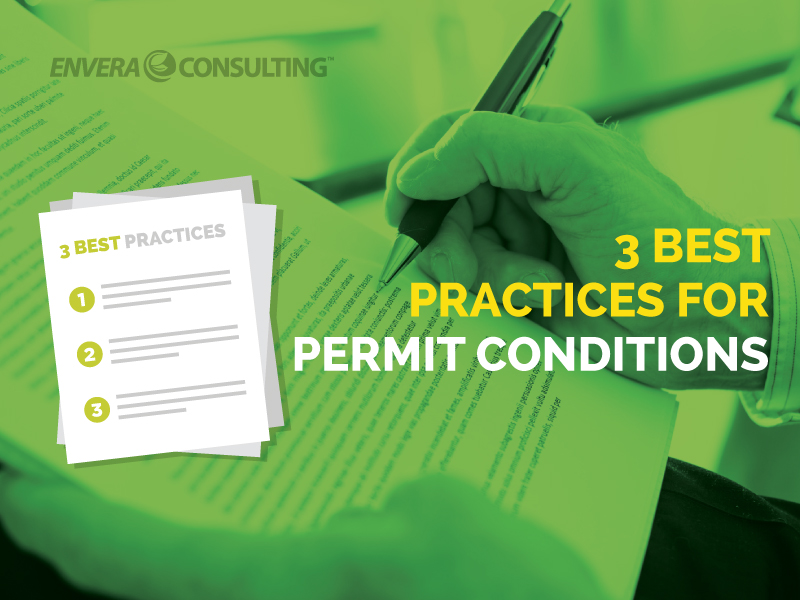

As explained in Rule 204, the South Coast Air Quality Management District (AQMD) proposes permit conditions in order to ensure compliance with all applicable regulations.
In addition, Rule 203 (b) says that a piece of equipment shall not be operated contrary to the conditions specific in the permit.
Permit conditions are proposed during the processing of your permit application, usually during the final phase. After reviewing your entire application, an AQMD engineer proposes conditions to ensure compliance with the rules. Not many people know this part: You can have some sway in the engineer’s decisions by proposing your own permit conditions. (More on that below.)
Generally speaking, permit conditions will require you to do one or more of the following:
- monitor your process and collect data
- submit reports
- maintain records
Here are some permit conditions we’ve seen recently:
- The temperature inside of the combustion chamber shall be kept to a minimum of 1,400 degrees Fahrenheit at all times.
- The amount of material processed by this equipment shall not exceed 120,000 pounds in any one calendar month. For purposes of this condition, “material processed” shall be defined as the amount of green bean coffee placed into the roast drum in any one calendar month.
- The emissions from this equipment shall not exceed 60 ppm NOx [parts per million of nitrogen oxide] corrected to 3% oxygen. To demonstrate compliance with this emission limit, the operator shall install a continuous emissions monitoring system consistent with the requirements of AQMD Rules 218 and 218.1.
With those examples in mind, here are three tips to guide you through proposing and receiving your permit conditions.
1. Propose your own permit conditions.
Even though the AQMD permitting process isn’t a choose-your-own-adventure, it’s more of a collaborative process than most people realize. If you think your facility is likely to have certain parts of its operation scrutinized, be proactive by recommending how this scrutiny should occur.
Of course, before you do so, you should have a clear understanding of what each condition will entail. For each condition you propose, think about what it will take to comply as well as how compliance will be demonstrated. What documents will you show the inspector to demonstrate that you have met the condition requirements? Will you need to implement a program to comply with the condition? Will you need to install/replace equipment or re-train staff? If the work seems too labor-intensive or costly, you may talk yourself out of proposing that condition and come up with another one.
In example condition A above, it’s common to keep and maintain the data generated from the temperature-sensing device used for this equipment. And when doing so, the data should show that the temperature is above 1,400 F, which is a pretty simple condition to comply with.
2. Think ahead when proposing conditions that require monitoring equipment.
Sometimes the AQMD requires that a parameter be monitored in order to demonstrate compliance. Some examples are bag leak detection systems (BLDS) and continuous emissions monitoring systems (CEMS).
If this is the case, you should consider the problems associated with having equipment that is continually on. How will you manage missing data? How much maintenance is required for such a system? What happens if the equipment breaks or has a problem with the probe? How do you know the equipment is collecting accurate data? How will you manage the data? We typically find that such systems are more effort than most people think.
In example condition B, having a CEMS can be a real headache because, in most cases, it can never be turned off. But if the rule requires the system, then you have to comply.
3. Don’t just accept AQMD-proposed conditions.
Remember: Just because the AQMD proposes a permit condition doesn’t mean you’re obliged to accept it (within reason).
It is entirely possible to be issued conditions that simply don’t make any sense. We see it all the time. The most common reason is not being completely clear in the permit application on how the equipment will operate. (See 6 Common Air Permit Problems [And How to Fix Them] for more on nonsensical and inaccurate permit conditions.) If a permit condition doesn’t make sense, review the rule it’s tied to so you can prepare to push back and ask for a change (but be professional about it).
Using example C, if a CEMS is not truly needed, you should state why you believe this condition should be removed, and cite the rule section that makes you believe so.
In all, the risk or probability for non-compliance generally increases as the number of permit conditions increases. So make sure you take the reins in your hands and make this a collaborative — rather than one-sided — process, both during the application process and when you review your issued permit.
Still have questions about permit conditions? Contact us and we’ll be happy to help you out.